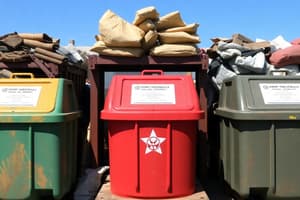Podcast
Questions and Answers
What is the primary difference between an aerobic bioreactor landfill and an anaerobic bioreactor landfill?
What is the primary difference between an aerobic bioreactor landfill and an anaerobic bioreactor landfill?
Which of the following accurately describes the purpose of the REACH regulation?
Which of the following accurately describes the purpose of the REACH regulation?
What does stabilization in waste management primarily aim to achieve?
What does stabilization in waste management primarily aim to achieve?
What is the significance of measuring the potentiometric surface in relation to aquifers?
What is the significance of measuring the potentiometric surface in relation to aquifers?
Signup and view all the answers
What is the main method used to estimate CO2 emissions within waste management?
What is the main method used to estimate CO2 emissions within waste management?
Signup and view all the answers
What is the primary goal of the National Ambient Air Quality Standards (NAAQS)?
What is the primary goal of the National Ambient Air Quality Standards (NAAQS)?
Signup and view all the answers
What defines a 'major source' of hazardous air pollutants under the Clean Air Act?
What defines a 'major source' of hazardous air pollutants under the Clean Air Act?
Signup and view all the answers
Which of the following best describes acid rain?
Which of the following best describes acid rain?
Signup and view all the answers
What is the focus of Title II of the Clean Air Act?
What is the focus of Title II of the Clean Air Act?
Signup and view all the answers
Which of the following pollutants is most commonly associated with vehicles and heavy equipment?
Which of the following pollutants is most commonly associated with vehicles and heavy equipment?
Signup and view all the answers
Under Title III of the Clean Air Act, what type of pollutants are classified as air toxics?
Under Title III of the Clean Air Act, what type of pollutants are classified as air toxics?
Signup and view all the answers
What does Title V of the Clean Air Act emphasize?
What does Title V of the Clean Air Act emphasize?
Signup and view all the answers
What does the Resource Conservation and Recovery Act (RCRA) primarily govern?
What does the Resource Conservation and Recovery Act (RCRA) primarily govern?
Signup and view all the answers
Which of the following is NOT defined as solid waste under RCRA?
Which of the following is NOT defined as solid waste under RCRA?
Signup and view all the answers
What is classified as universal waste?
What is classified as universal waste?
Signup and view all the answers
What is the primary purpose of the Toxic Substances Control Act (TSCA)?
What is the primary purpose of the Toxic Substances Control Act (TSCA)?
Signup and view all the answers
Which act was designed to address major threats to the environment such as acid rain and urban air pollution?
Which act was designed to address major threats to the environment such as acid rain and urban air pollution?
Signup and view all the answers
What does the Superfund program primarily focus on?
What does the Superfund program primarily focus on?
Signup and view all the answers
The SARA Title III Emergency Planning and Community Right-to-Know Act was developed in response to what event?
The SARA Title III Emergency Planning and Community Right-to-Know Act was developed in response to what event?
Signup and view all the answers
Who is considered a responsible party under the Comprehensive Environmental Response, Compensation, and Liability Act (CERCLA)?
Who is considered a responsible party under the Comprehensive Environmental Response, Compensation, and Liability Act (CERCLA)?
Signup and view all the answers
What type of waste includes materials like batteries and thermostats?
What type of waste includes materials like batteries and thermostats?
Signup and view all the answers
Which of the following acts focuses primarily on pesticide control?
Which of the following acts focuses primarily on pesticide control?
Signup and view all the answers
What is the primary function of a chelating agent?
What is the primary function of a chelating agent?
Signup and view all the answers
Which type of hydrocarbon includes one or more double bonds?
Which type of hydrocarbon includes one or more double bonds?
Signup and view all the answers
What is the final year by which Class I chemicals must be phased out?
What is the final year by which Class I chemicals must be phased out?
Signup and view all the answers
What is the latent heat of vaporization of water in Btu/lb?
What is the latent heat of vaporization of water in Btu/lb?
Signup and view all the answers
What type of penalties are imposed for knowing violations under Title VII?
What type of penalties are imposed for knowing violations under Title VII?
Signup and view all the answers
In the context of wastewater treatment, what process converts ammoniacal nitrogen to nitrate ion?
In the context of wastewater treatment, what process converts ammoniacal nitrogen to nitrate ion?
Signup and view all the answers
Which act requires all pesticides used in the United States to be registered with the EPA?
Which act requires all pesticides used in the United States to be registered with the EPA?
Signup and view all the answers
What does the acronym EVABAT stand for?
What does the acronym EVABAT stand for?
Signup and view all the answers
What is the role of catalytic combustion technology?
What is the role of catalytic combustion technology?
Signup and view all the answers
Which materials are included in the RoHS restrictions?
Which materials are included in the RoHS restrictions?
Signup and view all the answers
Which analytical technique uses electromagnetic radiation for qualitative analysis?
Which analytical technique uses electromagnetic radiation for qualitative analysis?
Signup and view all the answers
What focus does the National Environmental Protection Act (NEPA) primarily emphasize?
What focus does the National Environmental Protection Act (NEPA) primarily emphasize?
Signup and view all the answers
What defines the critical pressure of a substance?
What defines the critical pressure of a substance?
Signup and view all the answers
Which statement accurately describes the role of coliform bacteria in water quality assessment?
Which statement accurately describes the role of coliform bacteria in water quality assessment?
Signup and view all the answers
Which council is established to oversee the provisions of NEPA?
Which council is established to oversee the provisions of NEPA?
Signup and view all the answers
Which of the following is NOT classified under the materials exhibiting hazardous waste characteristics?
Which of the following is NOT classified under the materials exhibiting hazardous waste characteristics?
Signup and view all the answers
Which of the following statements is true regarding air pollution sources?
Which of the following statements is true regarding air pollution sources?
Signup and view all the answers
Which of the following correctly defines leachate?
Which of the following correctly defines leachate?
Signup and view all the answers
What is the primary aim of the stricter registration process mandated by FIFRA?
What is the primary aim of the stricter registration process mandated by FIFRA?
Signup and view all the answers
Flashcards
National Ambient Air Quality Standards (NAAQS)
National Ambient Air Quality Standards (NAAQS)
Regulations set by the EPA to protect public health and welfare by limiting air pollutants.
State Implementation Plans (SIPs)
State Implementation Plans (SIPs)
Plans created by states to meet the NAAQS standards.
Major Source
Major Source
Any stationary source that emits at least 10 tons per year of hazardous air pollutants or 25 tons per year of a combination of hazardous air pollutants.
Area Source
Area Source
Signup and view all the flashcards
Acid Rain
Acid Rain
Signup and view all the flashcards
Title V: Permits
Title V: Permits
Signup and view all the flashcards
Causes of Acid Rain
Causes of Acid Rain
Signup and view all the flashcards
What is a Buffer?
What is a Buffer?
Signup and view all the flashcards
What is a chelating agent?
What is a chelating agent?
Signup and view all the flashcards
What are Aldehydes and Ketones?
What are Aldehydes and Ketones?
Signup and view all the flashcards
What is Pyrolysis?
What is Pyrolysis?
Signup and view all the flashcards
What is Spectrophotometry?
What is Spectrophotometry?
Signup and view all the flashcards
What is Nitrification?
What is Nitrification?
Signup and view all the flashcards
What are Fibres?
What are Fibres?
Signup and view all the flashcards
What is the most common solvent?
What is the most common solvent?
Signup and view all the flashcards
What is critical pressure?
What is critical pressure?
Signup and view all the flashcards
What is Leachate?
What is Leachate?
Signup and view all the flashcards
Adsorption
Adsorption
Signup and view all the flashcards
Bioreactor Landfill
Bioreactor Landfill
Signup and view all the flashcards
Direct Measurement (CO2 Estimate)
Direct Measurement (CO2 Estimate)
Signup and view all the flashcards
Fuel Input Analysis (CO2 Estimate)
Fuel Input Analysis (CO2 Estimate)
Signup and view all the flashcards
Hazardous Waste Landfill
Hazardous Waste Landfill
Signup and view all the flashcards
RCRA (Resource Conservation and Recovery Act)
RCRA (Resource Conservation and Recovery Act)
Signup and view all the flashcards
Solid Waste
Solid Waste
Signup and view all the flashcards
Hazardous Waste
Hazardous Waste
Signup and view all the flashcards
Universal Waste
Universal Waste
Signup and view all the flashcards
TSCA (Toxic Substances Control Act)
TSCA (Toxic Substances Control Act)
Signup and view all the flashcards
FIFRA (Federal Insecticide, Fungicide, and Rodenticide Act)
FIFRA (Federal Insecticide, Fungicide, and Rodenticide Act)
Signup and view all the flashcards
Clean Air Act of 1990
Clean Air Act of 1990
Signup and view all the flashcards
CERCLA (Comprehensive Environmental Response, Compensation, and Liability Act) - Superfund
CERCLA (Comprehensive Environmental Response, Compensation, and Liability Act) - Superfund
Signup and view all the flashcards
SARA (Superfund Amendment and Reauthorization Act) Title III
SARA (Superfund Amendment and Reauthorization Act) Title III
Signup and view all the flashcards
Emergency Planning and Community Right-to-Know Act
Emergency Planning and Community Right-to-Know Act
Signup and view all the flashcards
Title VI: Stratospheric Ozone and Global Climate Protection
Title VI: Stratospheric Ozone and Global Climate Protection
Signup and view all the flashcards
Class I chemicals
Class I chemicals
Signup and view all the flashcards
Class II chemicals
Class II chemicals
Signup and view all the flashcards
Federal Insecticide, Fungicide, and Rodenticide Act (FIFRA)
Federal Insecticide, Fungicide, and Rodenticide Act (FIFRA)
Signup and view all the flashcards
EVABAT (Economic Viable Application of Best Available Technology)
EVABAT (Economic Viable Application of Best Available Technology)
Signup and view all the flashcards
National Environmental Protection Act (NEPA)
National Environmental Protection Act (NEPA)
Signup and view all the flashcards
Council on Environmental Quality (CEQ)
Council on Environmental Quality (CEQ)
Signup and view all the flashcards
RoHS
RoHS
Signup and view all the flashcards
Hazardous waste classification system - P/U, K, F, D
Hazardous waste classification system - P/U, K, F, D
Signup and view all the flashcards




